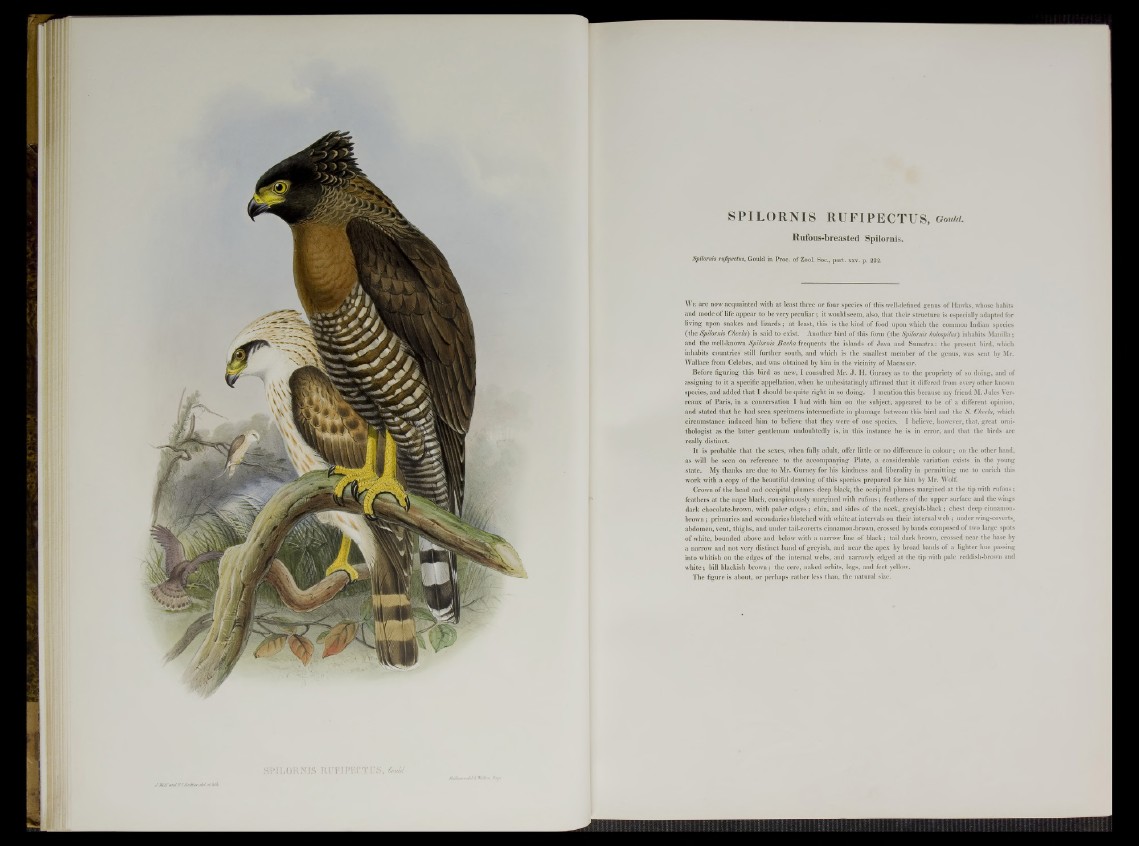
SPILORNIS RUFIPECTUS, Gouia.
Rufous-breasted Spilornis.
Spilornis rufipectus, Gould in Proc. of Zool. Soc., part. xxv. p. 222.
W e are now acquainted with at least three or four species of this well-defined genus of Hawks, whose habits
and mode of life appear to be very peculiar; it would seem, also, that their structure is especially adapted for
living upon snakes and lizards; at least, this is the kind of food upon which the common Indian species
(the Spilornis Cheela) is said to exist. Another bird of this form (the Spilornis holospilus) inhabits Manilla;
and the well-known Spilornis Bacha frequents the islands of Java and Sumatra: the present bird, which
inhabits countries still further south, and which is the smallest member of the genus, was sent by Mr.
Wallace from Celebes, and was obtained by him in the vicinity of Macassar.
Before figuring this bird as new, I consulted Mr. J. H. Gurney as to the propriety of so doing, and of
assigning to it a specific appellation, when he unhesitatingly affirmed that it differed from every other known
species, and added that I should be quite right in so doing. I mention this because my friend M. Jules Ver-
reaux of Paris, in a conversation I had with him on the subject, appeared to be of a different opinion,
and stated that he had seen specimens intermediate in plumage between this bird and the S. Cheela, which
circumstance induced him to believe that they were of one species. I believe, however, that, great ornithologist
as the latter gentleman undoubtedly is, in this instance he is in error, and that the birds are
really distinct.
It is probable that the sexes, when fully adult, offer little or no difference in colour; on the other hand,
as will be seen on reference to the accompanying Plate, a considerable variation exists in the young
state. My thanks are due to Mr. Gurney for his kindness and liberality in permitting me to enrich this
work with a copy of the beautiful drawing of this species prepared for him by Mr. Wolf.
Crown of the head and occipital plumes deep black, the occipital plumes margined at the tip with rufous;
feathers at the nape black, conspicuously margined with rufous; feathers of the upper surface and the wings
dark chocolate-brown, with paler edges; chin, and sides of the neck, greyish-black; chest deep cinnamon-
brown ; primaries and secondaries blotched with white at intervals on their internal web ; under wing-coverts,
abdomen, vent, thighs, and under tail-coverts cinnamon-brown, crossed by bands composed of two large spots
of white, bounded above and below with a narrow line of black; tail dark brown, crossed near the base by
a narrow and not very distinct band of greyish, and near the apex by broad bands of a lighter hue passing
into whitish on the edges of the internal webs, and narrowly edged at the tip with pale reddish-brown and
white; bill blackish brown; the cere, naked orbits, legs, and feet yellow.
The figure is about, or perhaps rather less than, the natural size.